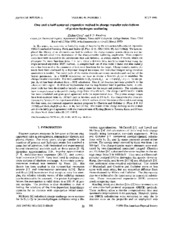| dc.creator | Chen, Z. F. | |
| dc.creator | Reading, John F. | |
| dc.date.accessioned | 2011-09-08T21:35:44Z | |
| dc.date.available | 2011-09-08T21:35:44Z | |
| dc.date.issued | 1993 | |
| dc.identifier.citation | Z. F. Chen and John F. Reading. Phys.Rev.A 48 352-356 1993. "Copyright (1993) by the American Physical Society." | en |
| dc.identifier.uri | http://dx.doi.org/10.1103/PhysRevA.48.352 | |
| dc.identifier.uri | https://hdl.handle.net/1969.1/126527 | |
| dc.description | Journals published by the American Physical Society can be found at http://publish.aps.org/ | en |
| dc.description.abstract | In this paper, we undertake a feasibility study of improving the one-and-a-half-centered expansion (OHCE) method of Reading, Ford, and Becker [J. Phys. B 14, 1995 (198 1) | en |
| dc.description.abstract | 15, 3257 (1982)]. We have explored the efficacy of an alternative method to evaluate the charge-transfer matrix elements and improved the estimated time dependence of the charge-transfer scattering amplitudes. More projectile states have been included in the calculations than used hitherto. A unitary matrix, U matrix, which can propagate the wave functions from -infinity to t, where t denotes time, has been constructed using the single-centered expansion (SCE) method. A complex basis set of nine radial s states and nine radial p states has been used in the expansion of trial wave functions for the target. Charge-transfer matrix elements have been evaluated by a Feynman integral technique | en |
| dc.description.abstract | one numerical integral using Gaussian quadrature is needed. The radial parts of the matrix elements are stored on circles and used for all the impact parameters. In a OHCE calculation, we have to choose a function beta(m)(z) to modulate the charge-transfer amplitudes. The only constraints on beta(m)(z) are beta(m)(-infinity) = 0 and beta(m)(infinity) = 1. In this paper, beta(m)(z) has been obtained from a SCE calculation. This beta(m)(z) function increases gradually in the whole collision region. It offers an improvement over the step function used in previous work. A computer code has been developed to include s and p states for the target and projectile. The calculations have been performed in the proton energy range from 30 to 250 keV. The charge transfer to the Is state has been calculated and gives good agreement with the experimental data. The proton energy ranges have been extended from the 100 keV used in previous work to 250 keV. The charge-transfer cross sections to the 2p state fit the experimental data at 30 keV and are almost the same as those calculated using the four-state, two-centered expansion method proposed by Cheshire and Gallaher [J. Phys. B 3, 813 (1970)] and Shakeshaft [Phys. Rev. A 14, 1626 (1976)]. The results of the charge exchange to the 2s state are also in fairly good agreement with the measurements of Ryding [listed in Tawara, Kato, and Nakar, At. Data Nucl. Data Tables 32, 235 (1985)]. | en |
| dc.language.iso | en | |
| dc.publisher | American Physical Society | |
| dc.subject | COUPLED-STATE CALCULATIONS | en |
| dc.subject | COLLISIONS | en |
| dc.subject | Optics | en |
| dc.subject | Physics | en |
| dc.title | One-And-A-Half-Centered Expansion Method in Charge-Transfer Calculations of Proton-Hydrogen Scattering | en |
| dc.type | Article | en |
| local.department | Physics and Astronomy | en |


